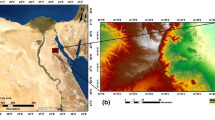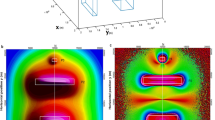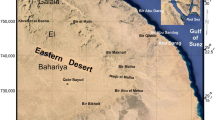Abstract
We present the detail basement and trends of geological structures associated with the Mesozoic-Cenozoic volcanism in the south–western region of the Nigerian Benue trough using recent gravity and magnetic anomalies of the region. The analysis aimed at recognizing and mapping the basement structure that controlled the distribution and source host of hydrocarbon and other economic mineral resources in the region. The structural recognition and mapping is done on the basis of the utilization of the Tilt Angle (TA) and Total Horizontal Derivative of the Tilt Angle (THDTA) of gravity and magnetic data. From these techniques, we have been able to identify and mapped out those edges of anomalous sources due to the gravity and magnetic data that are in association with the basement geological structures of the area. Based on the mapped structural trends, it is observed that the basement structures derived from both the gravity and magnetic anomalies correlated well with the zones of volcanic rocks around Gboko and area between Lefin and Oturkpo. The two locations are sitting over gravity and magnetic highs suggesting high density and susceptibility material below the subsurface. The Euler deconvolution method suggested depths between 1 and 5 km from both gravity and magnetic data. Deeper basement of anomalous sources are suggested between 3 and 5 km. The 1 km depth interprets the regions of basement highs or corresponding to intrusive zones.










Similar content being viewed by others
References
Abdelrahman EM, El-Araby HM, El-Araby TM, Essa KS (2003a) A least-squares minimization approach to depth determination from magnetic data. Pure Appl Geophys 160:1259–1271
Abdelrahman EM, El-Araby TM, Essa KS (2003b) Shape and depth solutions from third moving average residual gravity anomalies using the window curves method. Kuwait J Sci Eng 30:95–108
Abdelrahman EM, El-Araby TM, Essa KS (2003c) A least-squares minimisation approach to depth, index parameter, and amplitude coefficient determination from magnetic anomalies due to thin dykes. Explor Geophys 34:241–248
Abdelrahman EM, Abo-Ezz ER, Essa KS, El-Araby TM, Soliman KS (2007) A new least-squares minimization approach to depth and shape determination from magnetic data. Geophys Prospect 55:433–446
Abdullahi M, Kumar R (2020) Curie depth estimated from high-resolution aeromagnetic data of parts of lower and middle Benue trough (Nigeria). Acta Geod Geoph 55(4):627–643
Abdullahi M, Kumar R (2021) Basement and structure near the southwestern margin of the lower Benue trough between, and including, the Anambra Basin and Afikpo Syncline, as derived from aeromagnetic and gravity data. Pure Appl Geophys. https://doi.org/10.1007/s00024-021-02801-3
Abdullahi M, Singh UK (2018) Basement geology derived from gravity anomalies beneath the Benue trough of Nigeria. Arab J Geosci 11:694
Abdullahi M, Singh UK, Roshan R (2019a) Mapping magnetic lineaments and subsurface basement beneath parts of lower Benue trough (LBT), Nigeria: insights from integrating gravity, magnetic and geologic data. J Earth Syst Sci 128:17
Abdullahi M, Kumar R, Singh UK (2019b) Magnetic basement depth from high-resolution aeromagnetic data of parts of lower and middle Benue trough (Nigeria) using scaling spectral method. J Afr Earth Sci 150:337–345
Abdullahi M, Singh UK, Modibbo UM (2019c) Crustal structure of southern Benue trough, Nigeria from 3D inversion of gravity data. J Geol Min Res 11(4):39–47
Adighije C (1981) A gravity interpretation of the Benue trough, Nigeria. Tectonophysics 79:109–128
Agagu OK, Adighije CI (1983) Tectonic and sedimentation framework of the lower Benue trough, southeastern Nigeria. J Afr Earth Sci 1(3/4):267–274
Ajayi CO, Ajakaiye DE (1981) The origin and perculiarities of the Nigerian Benue trough: another look from recent gravity data obtained from middle Benue. Tectonophysics 80:285–303
Ajayi CO, Ajakaiye DE (1986) Structures deduced from gravity data in the middle Benue trough, Nigeria. J Afr Earth Sci 5:359–369
Anudu GK, Stephenson RA, Macdonald DIM (2014) Using high-resolution aeromagnetic data to recognize and map intra-sedimentary volcanic rocks and geological structures across the cretaceous middle Benue trough, Nigeria. J Afr Earth Sci 99:625–636
Benkhelil J (1989) The origin and evolution of the cretaceous Benue trough (Nigeria). J Afr Earth Sci 6:251–282
Brethes A, Guarnieri P, Rasmussen TM, Bauer TE (2018) Interpretation of aeromagnetic data in the jameson land basin, central east greenland: structures and related mineralized systems. Tectonophysics. https://doi.org/10.1016/j.tecto.2018.01.008
Cooper GRJ, Cowan DR (2006) Enhancing potential field data using filters based on the local phase. Comput Geosci 32(10):1585–1591
Essa KS, Diab ZE (2022) Source parameters estimation from gravity data using bat algorithm with application to geothermal and volcanic activity. Intl J Environ Sci Tech. https://doi.org/10.1007/s13762-022-04263-z
Essa KS, Géraud Y (2020) Parameters estimation from the gravity anomaly caused by the two-dimensional horizontal thin sheet applying the global particle swarm algorithm. J Petrol Sci Eng 193:107421
Essa KS, Nady AG, Mostafa MS, Elhussein M (2018) Implementation of potential field data to depict the structural lineaments of the Sinai Peninsula. Egypt J Afr Earth Sci 147:43–53
Essa KS, Abo-Ezz ER, Géraud Y, Diraison M (2022) A full interpretation applying a metaheuristic particle swarm for gravity data of an active mud diaper SW Taiwan. J Petrol Sci Eng 215:110683
Farrington JL (1952) A preliminary description of the Nigerian lead-zinc field. Econ Geol 47:583–608
Idi BY, Maiha AI, Abdullahi M (2022) Spatial mapping and monitoring thermal anomaly and radiative heat flux using Landsat-8 thermal infrared data-a case study of Lamude hot spring, upper part of Benue trough. Nigeria. J Appl Geophys 203:104654
Keating PB (1998) Weighted Euler deconvolution of gravity data. Geophysics 63:1595–1603
King LC (1950) Outline and disruption of Gondwanaland. Geol Mag 87:353–359
Maluski H, Coulon C, Popoff M, Baudin P (1995) 40Ar/39Ar chronology, petrology and geodynamic setting of Mesozoic to early Cenozoic magmatism from the Benue trough, Nigeria. J Geol Soc 152:311–326
Miller HG, Singh V (1994) Potential field tilt—a new concept for location of potential field sources. J Appl Geophys 32:213–217
Nwachukwu SO (1972) The tectonic evolution of the southern portion of the Benue trough Nigeria. Geol Mag 109:411–419
Ofoegbu CO (1984) Interpretation of aeromagnetic anomalies over lower and middle Benue trough of Nigeria. Geophys J Roy Astro Soc 79:813–823
Ofoegbu CO (1985) A review of the geology of the Benue trough Nigeria. J Afr Earth Sci 3(3):283–291
Ofoegbu CO, Onuoha KM (1991) Analysis of magnetic data over the Abakaliki Anticlinorium of the lower Benue trough, Nigeria. Mar Petrol Geol 8:174–183
Ogungbesan GO, Adedosu TA (2019) Geochemical record for the depositional condition and petroleum potential of the late cretaceous mamu formation in the western flank of anambra basin. Green Energy Environ. https://doi.org/10.1016/j.gee.2019.01.008
Olade MA (1978) Early Cretaceous basalt volcanism and initial continental rifting in Benue trough, Nigeria. Nature 273:458–559
Oruc B (2011) Edge detection and depth estimation using a tilt angle map from gravity gradient data of the Kozaklı-Central Anatolia region, Turkey. Pure Appl Geophys 168:1769–1780
Reid AB, Thurston JB (2014) The structural index in gravity and magnetic interpretation: errors, uses, and abuses. Geophysics 79(4):J61–J66
Reid AB, Allsop JM, Granser H, Miliett AJ, Somerton WI (1990) Magnetic interpretations in three dimensions using Euler deconvolution. Geophysics 55:80–91
Reid AB (1995) Euler deconvolution: past, present, and future: a review. Tulsa: extended abstract of the 65th annual meeting of the society of exploration geophysics. 272–273
Salem A, Williams S, Fairhead D, Smith R, Ravat D (2008) Interpretation of magnetic data using tilt-angle derivatives. Geophysics 73:L1–L10
Teknik V, Thybo H, Artemieva IM, Ghods A (2020) A new tectonic map of the Iranian plateau based on aeromagnetic identification of magmatic arcs and ophiolite belts. Tectonophysics 792:228588
Uzuakpunwa AB (1974) The Abakaliki pyroclastics, Eastern Nigeria, new age and tectonic implications. Geol Mag 111:65–70
Verduzco B, Fairhead JD, Green CM, Mackenzie C (2004) New insights into magnetic derivatives for structural mapping. Lead Edge 23:116–119
Wright JB (1968) South Atlantic continental drift and the Benue Trough. Tectonophysics 6:301–310
Wright JB (1976) Origins of the Benue trough–a critical reviews. In: Kogbe CA (ed) Geology of Nigeria. Elizabethan publication co., Lagos, pp 313–318
Wright JB (1989) Volcanic rocks in Nigeria. In: Kogbe CA (ed) Geology of Nigeria, 2nd edn. Rock View Nigeria Ltd., Jos, pp 125–174
Acknowledgements
The authors acknowledged the Nigerian Geological Survey Agency (NGSA), Abuja office for providing the high-resolution airborne gravity and magnetic data for this work. We appreciate the valuable observations and constructive comments of the two anonymous reviewers.
Author information
Authors and Affiliations
Corresponding author
Ethics declarations
Conflict of interest
The authors declared that they don’t have any conflict of interest as to this submission.
Additional information
Edited by Prof. Teresa Grabowska (ASSOCIATE EDITOR) / Prof. Ramón Zúñiga (CO-EDITOR-IN-CHIEF).
Rights and permissions
Springer Nature or its licensor (e.g. a society or other partner) holds exclusive rights to this article under a publishing agreement with the author(s) or other rightsholder(s); author self-archiving of the accepted manuscript version of this article is solely governed by the terms of such publishing agreement and applicable law.
About this article
Cite this article
Abdullahi, M., Kumar, R., Idi, B.Y. et al. Analysis of recent airborne gravity and magnetic data for the interpretation of basement structures underneath the south–western Benue trough using source edge detector filters. Acta Geophys. 71, 1595–1606 (2023). https://doi.org/10.1007/s11600-023-01060-1
Received:
Accepted:
Published:
Issue Date:
DOI: https://doi.org/10.1007/s11600-023-01060-1




